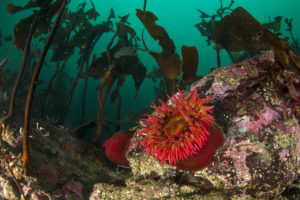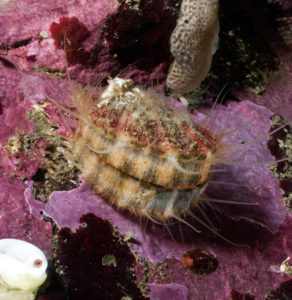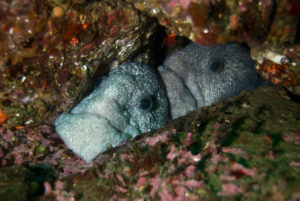March 1, 2017
By: Shilpi Chhotray, Mission Blue Communications Strategist
Did you know the cool waters of Vancouver Island provide some of the greatest diversity of marine life in North America? In fact, underwater explorer and filmmaker Jacques Cousteau remarked “it’s the best temperate-water diving in the world and second only to the Red Sea.” Saanich Inlet and the Southern Gulf Islands in particular are rich with ecologically diverse creatures and plants unique from anywhere else in the world. Small rocky outcrops create private sanctuaries for a wide variety of sea birds and marine mammals while kelp forests are filled with schools of fish, colorful anemones and sponges, pods of Orca whales, and the elusive Giant Pacific octopus.
It Takes a Village
In addition to spectacular endemic marine life, the Island’s small communities including many vibrant First Nations have engendered strong ties to the ocean for generations. By working together to promote education and awareness of the islands’ ecological significance, robust programs around shoreline and underwater clean-up, sustainable fishing, enhanced conservation areas, and a greater emphasis on preventing poaching are prioritized. Due to a lack of resources from the
Canadian Department of Fisheries and Oceans, communities watch for poachers and share images with law enforcement to help with illegal activity.
The diving community is particularly active in sustainable management practices that increase and maintain the health of the Hope Spot. Alisa Preston, local resident and Director of
Rockfish Divers indicates:
“Divers are the ambassadors of the ocean, as we experience the stunning diversity of our local marine ecosystems firsthand. Our scuba and freediving training programs specifically include environmental education to better understand society’s impact on the underwater world. Students instill a desire to protect what lies beneath the surface and further support our community to preserve and enhance what we have today.”
 Disrupting the Islands’ Natural Balance
Disrupting the Islands’ Natural Balance The Saanich Inlet and the Southern Gulf Islands Hope Spot may be rich with ecologically diverse creatures and plants unique from anywhere else in the world, but overfishing, heavy marine traffic, and urban development are impacting its natural balance. Residing next to a major city like Victoria has its challenges. Agricultural run-off affects ecological and culturally sensitive areas like the Ancient Sea Gardens used by First Nations for sustainable shellfish harvesting. Oil spills are also a major concern to the islands. In April 2011,
about 43,000 liters of gasoline and 700 liters of diesel spilled into the Goldstream River which enjoys thousands of salmon returning each year, harming fish and other wildlife in the area. And an unrelated but devastating event called the
Sea Star Wasting Syndrome struck at the end of 2013, killing off most of the sea star population and impacting almost all the marine species in the islands.
The Hope Spot has experienced its fair share of challenges and the largest threats to date are currently underway: a proposal for a Liquid Natural Gas (LNG) plant in Saanich Inlet and increased crude oil shipping traffic around the Southern Gulf Islands. The LNG facility would use ocean water as a coolant for the heat exchange process to liquify natural gas. When the water is returned to the marine environment, it poses a threat of raising the temperature of surrounding waters leading to ocean warming and acidification. LNG pipelines used to transport natural gas are another potential spill source which may release toxic levels of methane. Finally, shipping of crude oil in the Southern Gulf Islands increases the chances of a devastating oil spill. Both threats directly impact marine life and surrounding communities. Alisa further explains:
“Construction of the pipelines associated with this project will compromise the local environment, as it travels through all sorts of sensitive environments including deep sea glass sponge gardens and shallow eel grass beds critical to the health of the ocean.”
Learning from the Past
Despite no industrial activity for decades, the long term impact on the environment is apparent. Data that supported a
Saanich Inlet Study in 1996 indicates residual signs of chemical contamination still apparent in shellfish today. The Hope Spot designation aims to deepen local commitments by encouraging communities to address past damages and prevent further degradation.
As we’ve learned time and time again, crude oil spills have catastrophic impacts to human and wildlife as well local marine industries. Fishing and tourism alone in the Greater Victoria area, including Saanich Inlet and the Southern Gulf Islands, generates 21,000 jobs that would be threatened if not lost permanently in the event of a major spill. Currently, there are not enough resources or a sufficient plan in place for when a disaster of this magnitude may strike. A coordinated spill response is necessary to avoid wide spread devastation and potential fatalities, as we have learned from other areas in the past (i.e.
Exxon Valdez Spill and
BP/Gulf Oil Spill).
Driving Towards the Future
Protecting the economic, cultural, and recreational significance is of utmost importance to the Saanich Inlet and the Southern Gulf Islands Hope Spot. Once ocean and coastal ecosystems are destroyed, they may never recover the marine life and livelihoods affected. Adam Olsen, a member of the Tsartlip First Nation and recent Deputy Leader of the BC Green Party describes the Saanich Inlet as a very special place. He remarks:
 “It has been home to my ancestors for countless generations and it’s where I grew up fishing and playing. We have a great deal of work to get it back to the biodiversity and productivity it was once known for but through the incredible efforts of local residents, it’s making a comeback. With another generation of heavy industry proposed for the Saanich Inlet we must reaffirm our commitment to a better future rather than chasing 20th-century industries.”
“It has been home to my ancestors for countless generations and it’s where I grew up fishing and playing. We have a great deal of work to get it back to the biodiversity and productivity it was once known for but through the incredible efforts of local residents, it’s making a comeback. With another generation of heavy industry proposed for the Saanich Inlet we must reaffirm our commitment to a better future rather than chasing 20th-century industries.”
Adam believes the Mission Blue Hope Spot designation is another step toward embracing the opportunities created by protecting common spaces, enhancing diversity and nurturing the life-sustaining eco-systems that surround us. Together, we strongly urge the Canadian and British Columbian governments to reconsider the proposed LNG project and alternatively invest in local tourism supporting the Saanich Inlet and Southern Gulf Islands being one of the most beautiful places in the world.
“It has been home to my ancestors for countless generations and it’s where I grew up fishing and playing. We have a great deal of work to get it back to the biodiversity and productivity it was once known for but through the incredible efforts of local residents, it’s making a comeback. With another generation of heavy industry proposed for the Saanich Inlet we must reaffirm our commitment to a better future rather than chasing 20th-century industries.”











Ok, so what can be done? People want to help, but must be directed to specific actions.
Important to note, the fuel spill in 2011 was not just 700l of diesel but the entire cargo of the fuel truck, 43,000l of gas.